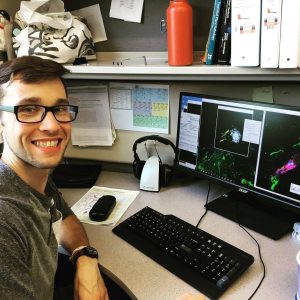
Researchers in Saskia Neher’s lab have used cryoelectron microscopy (CryoEM) to solve the structure of the protein lipoprotein lipase (LPL) forming a novel helical assembly. LPL is a crucial metabolic protein that helps breakdown and remove fat from the blood, and has long been of interest to the Neher lab. The structural work was spearheaded by Dr. Kathryn Gunn, a postdoctoral fellow in the lab and showed that the LPL helix is a new oligomeric form of LPL, in which LPL adopts an inactive configuration.

In order to explore if helical LPL could be observed in cells, graduate student, Benjamin Roberts, turned to super resolution fluorescent microscopy, a cutting edge technique that allows scientists to observe cellular structures below 200 nm in size. They found that in fat cells LPL creates filament like structures inside of storage vesicles. The helical form of LPL is likely what gives rise to the filamentous structures, indicating helical LPL in an inactivate storage form adopted before LPL is released into the capillaries to breakdown fat. This highlights the use of dynamic assembly state as a way for cells to regulate protein function.
Authors: Kathryn H. Gunn1, Benjamin S. Roberts1, Fengbin Wang2, Joshua D. Strauss3, Mario J. Borgnia3, Edward H. Egelman2, and Saskia B. Neher1*
1 Department of Biochemistry and Biophysics, University of North Carolina, Chapel Hill, North Carolina, 27599, USA
2 Department of Biochemistry and Molecular Genetics, University of Virginia School of Medicine, Charlottesville, Virginia, 22908, USA
3 Genome Integrity and Structural Biology Laboratory, National Institute of Environmental Health Sciences, National Institutes of Health, Department of Health and Human Services, North Carolina, 27709, USA
